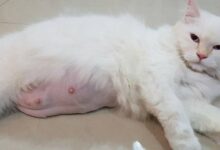If you’ve ever wondered: “Why Do Male Cats Have Nipples?” you aren’t alone! Many female cats are born with these bumps on their stomachs, but what makes male cats develop them? It’s a mystery to most people, but you may find some clues in this article. Nipples are sensitive structures that produce milk. While male cats don’t produce milk, they do attempt to suckle kittens. If they don’t have enough hair to nurse a kitten, their nipples may become infected. Stressful situations and overgrooming may also cause hair loss on the nipples.
The development of nipples begins early in a cat’s development. The male’s fetus is nearly identical to a female’s, but testosterone prevents the development of the mammary gland in the kitten. In humans, the coccyx bone is the result of the male’s genetics, but it’s not clear exactly why males develop nipples.
Male cats have a total of eight nipples, and individual cats may have more or fewer. Although males don’t use their nipples to feed kittens, they do have the nipples for breeding. Males aren’t supposed to raise kittens. Their bodies are designed for feeding and nurturing their young. If they aren’t doing so, it’s time for them to be neutered or spayed.
Female nipples are larger, heavier, and vascular than those of male cats. Unlike females, nipples in male cats aren’t visible to the untrained eye, which is why some cat owners mistake them for ticks. However, male nipples don’t function as milk delivery organs. Instead, they serve a protective and decorative purpose.
While you may not notice them if your cat has long hair, you’ll probably notice them if he has short hair. And yes, male cats do have nipples, too! Nipples are a part of the male anatomy, and all mammals have them. Female and male embryos are almost identical, as they both have nipples during development. But what does it all mean?
Infections
Feline Mycoplasma turicensis (CMT) is the most common of the four mycoplasma species found in the blood of feline patients. PCR has shown linear amplification in feline samples over nine orders of magnitude. PCR results for “Candidatus Mycoplasma turicensis” were negative in cats tested for M. haemofelis and M. haemominutum when 104 copies of standard plasmid DNA from a nonmatching species were used.

Infections in male cats are common in areas where outdoor access is common. Cats are susceptible to HWI when exposed to blood-sucking arthropods, but clinical symptoms can develop within 3 months of infection. Infections with mature stages are usually not fatal, although clinical signs may occur within 7 months. Male cats may also develop heart failure or pulmonary thromboembolism after exposure to blood from an infected cat.
Mammary tumors
If you’ve ever wondered why male cats have nipples, rest assured that it is a perfectly normal and perfectly natural part of a cat’s body. Male cats have nipples, and they are actually vestigial structures that serve no practical purpose. Nipples on a cat are a vestigial structure, a leftover from development, and the cat doesn’t need them to feed its young.
While male cats don’t normally have nipples, they are very common in unspayed female cats. It’s important to check if your cat has nipples if you have a cat, and if so, be sure to wear protective handwear if you have to touch them. If you notice that the cat has nipples, you can also take precautions to keep the bumps from becoming infected.
Breast cancer

Did you know that male cats have nipples? They are found in both sexes but the nipples of male cats are much smaller than those of females. This is because males do not develop a full mammary system, which is more energy and resource intensive. Nipples are made up of tissue, nerves, and skin. They do not have any specific function, but they are present in both sexes.
Female cats can also develop a nipple infection. While female cats get it due to lactation, males can also get it due to physical injury. Bruising may develop around the nipples of male cats, and they may have mastitis. Fortunately, both conditions are treatable. For more information on feline mastitis, contact your veterinarian today!

